
JULY 2023 • Vol.10 • No.07 (ISSN 2564-1980) WHY AMERICAN EMPLOYERS SHOULD EXPLORE NEW WAYS TO OFFER FAMILY-FORMING BENEFITS - Dr. G. David Adamson, Founder, Chairman, and CEO, ARC Fertility 21 10 28 34 Fertility Benefits In The Workplace: The Great Confrontation And The Quest For Top Talent - Liz Pittinger, Stork Club Popular Workplace Demands 2023: Menopause Leave Tops The List - Bradford Goodwin, Lensa From Burnout To Balance: How Companies Can Fully Support Workforce Well-Being - Neil King, TELUS Health Using Life Insurance To Attract And Retain Gig Workers - Bob Gaydos, Pendella


Articles Why American Employers Should Explore New Ways To Offer Family-Forming Benefits The impact of the Covid-19 baby boom – Dr. G. David Adamson, Founder, Chairman, and CEO, ARC Fertility 07 On the Cover INDEX Employee Benefits & Wellness Excellence JULY 2023 Vol.10 No.07 37 Unmasking The Sales Myth: Mental Health Matters The human side of sales – Rana Salman, Ph.D., Founder, Salman Consulting, LLC (ISSN 2564-1980) 14 Digital Wellness – From a Scaffold to a Pillar of Employee Well-Being – The HR Research Institute, powered by HR.com 23 What Goes Up Must Come Down How to understand and mitigate stress among remote and hybrid workers – Edward J. Beltran, CEO, Fierce Conversations 31 Just Say ‘No’ To Toxic People Common toxic behaviors to watch out for – Ken Keis, Ph.D., President and CEO, Consulting Resource Group International, Inc. (CRG) Sponsored Article
Fertility Benefits In The Workplace: The Great Confrontation And The Quest For Top Talent

Aligning with DEI and ESG principles to attract top talent
- Liz Pittinger, Head of Customer Success, Stork Club
Top Picks 10 21 28
Popular Workplace Demands 2023: Menopause Leave Tops The List

Unveiling employee priorities in an evolving landscape
- Bradford Goodwin, Content Strategist, Lensa
INDEX
From Burnout To Balance: How Companies Can Fully Support Workforce Well-Being

The current state of employee mental health
- Neil King, Managing Director, Employer Solutions, TELUS Health
34
Using Life Insurance To Attract And Retain Gig Workers

Addressing the benefits gap in the gig economy
- Bob Gaydos, Founder & CEO, Pendella
How are our Employee Benefits & Wellness Products and Services helping
Benefits & Wellness Excellence - Monthly Interactive Learning Journal
This monthly interactive learning experience captures key metrics and actionable items and keeps you focused on your Benefits and Wellness planning goals and solutions.
Benefits and Wellness Virtual Events

Employee Benefits and Wellness Virtual Events ensure attendees stay compliant and up-to-date with the latest changes to employee benefits and wellness regulations. Each event varies on topics such as healthcare legislation and compliance related to employee benefits and workplace wellness programs including COBRA, FMLA, Medical Benefits, the Affordable Care Act (ACA), Outsourcing Benefits, Retirement Benefits, Voluntary Benefits and Work-Life Programs. Wellness topics encompass injury prevention, battling obesity, disease prevention, how technology is affecting wellness. Each Virtual Event consists of up to 10 credit webcasts.
Benefits and Wellness Webcasts for Credit

HR.com webcasts deliver the latest Benefits and Wellness industry news, research trends, best practices and case studies directly to your desktop. Webcasts are available live online with a downloadable podcast and a copy of the slides (PDF) available before and after each webcast. Earn all of the required recertification credits for aPHR, PHR, SPHR, GPHR, and SHRM Certifications. HR.com’s onehour webcasts, in every HR specialty including Benefits and Wellness, are pre-approved for HRCI and SHRM credit (excluding Demo webcasts).
Benefits and Wellness Community
Join more than 100,000 HR.com members with a similar interest and focus on Benefits or Wellness. Share content and download research reports, blogs, and articles, network, and “follow” peers and have them “follow” you in a social network platform to communicate regularly and stay on top of the latest updates. This well established Benefits and Wellness Communities are an invaluable resource for any HR professional or manager.
to make you smarter?
For more information phone: 1.877.472.6648 | email: sales@hr.com | www.hr.com
Use these invaluable Employee Benefits & Wellness resources today!
Editorial Purpose
Our mission is to promote personal and professional development based on constructive values, sound ethics, and timeless principles.
Excellence Publications
Debbie McGrath CEO, HR.com - Publisher
Sue Kelley Director (Product, Marketing, and Research)
Babitha Balakrishnan and Deepa Damodaran Excellence Publications Managers and Editors
Employee Benefits & Wellness Excellence Team
Babitha Balakrishnan Editor

Arun Kumar R Design and Layout (Digital Magazine)
Chandra Shekar A K Magazine (Online Version)
Submissions & Correspondence
Please send any correspondence, articles, letters to the editor, and requests to reprint, republish, or excerpt articles to ePubEditors@hr.com
For customer service, or information on products and services, call 1-877-472-6648
For Advertising Opportunities, email: sales@hr.com
Employee Benefits & Wellness
Excellence (ISSN 2564-1980)
is published monthly by HR.com Limited, 56 Malone Road, Jacksons Point, Ontario L0E 1L0 Internet Address: www.hr.com
Debbie Mcgrath Publisher, HR.com
Balakrishnan Editor, Employee Benefits & Wellness Excellence
Navigating the Changing Landscape of Workforce Well-being
Intoday's fast-paced and dynamic work environment, achieving success hinges on recognizing and addressing key factors that contribute to a flourishing workforce.
Read the July edition of Employee Benefits & Wellness Excellence to explore in-depth articles on the most sought-after benefits by employees, the crucial role of mental health programs in fostering a thriving workforce, how life insurance can empower gig workers for a successful future, and much more.
The Covid-19 pandemic brought about many unexpected changes, and one of them was a surprising mini-baby boom in the U.S. Fertility rates rose by 6.2% after a long decline, and part of this can be attributed to the flexibility provided by remote work models. Employees were able to balance their family life and career more effectively, making comprehensive reproductive health benefits essential for retaining top talent in the workforce. Dr. G. David Adamson's (Founder, Chairman, and CEO of ARC Fertility) article, Why American Employers Should Explore New Ways To Offer Family-Forming Benefits, highlights the significance of family-forming benefits in the workplace and how they can positively impact employee retention and overall workplace culture.
Liz Pittinger's (Stork Club) article, Fertility Benefits In The Workplace: The Great Confrontation And The Quest For Top Talent, sheds light on the importance of impactful incentives like family-building benefits that make an outsized difference in the decisions of prospective and current employees.

The lens on trending employee demands for 2023 paints a compelling picture. Among the top demands is "Menopause Leave," which has seen a remarkable surge of 336% in searches. Explore the comprehensive insights on the top employee demands that are shaping the modern workforce in Brad Goodwin's (Lensa) article,
Popular Workplace Demands 2023: Menopause Leave Tops The List.
The TELUS Mental Health Index conducted in April 2023 reveals a concerning reality: three out of five U.S. workers are at moderate or high risk of developing mental health conditions. Workplace health programs that protect employees' overall health and productivity can contribute to a healthier, more engaged, and productive workforce, according to Neil King's (MD, Employer Solutions, TELUS Health) article, From Burnout To Balance: How Companies Can Fully Support Workforce Well-Being.
Offering life insurance as a benefit, combined with indemnity coverage, can be a game-changer for gig workers. Bob Gaydos' (Founder & CEO, Pendella) article, Using Life Insurance To Attract And Retain Gig Workers, explores this topic in-depth, offering valuable insights into the potential benefits of life insurance for attracting and retaining gig workers.
In brief, the July edition of Employee Benefits & Wellness Excellence explores essential elements that contribute to a thriving workforce.
We trust that you will find these articles both informative and valuable for staying ahead in the rapidly evolving field of human resources.
Be sure to send us your valuable feedback on our articles. Your input is important to us as we strive to continually improve and provide content that meets your needs and interests.
Happy Reading!
Write to the Editor at ePubEditors@hr.com
The views, information, or opinions expressed in the Excellence ePublications are solely those of the authors and do not necessarily represent those of HR.com and its employees. Under no circumstances shall HR.com or its partners or affiliates be responsible or liable for any indirect or incidental damages arising out of these opinions and content. EDITOR’S NOTE
Disclaimer:
Subscribe now for $99 / year And get this magazine delivered to your inbox every month Become a Member Today to get it FREE! SIGN UP OR
be
or
any form
Copyright © 2023 HR.com. No part of this publication may
reproduced
transmitted in
without written permission from the publisher. Quotations must be credited.
Babitha
In a world of unparalleled challenges (global pandemic, racial injustice, political rivalry, digital 4.0, emotional malaise), uncertainty reigns. Finding opportunity in this context requires harnessing uncertainty and harnessing starts with reliable, valid, timely, and useful information. The Excellence publications are a superb source of such information. The authors provide insights with impact that will guide thought and action.
Dave Ulrich

Excellence publications are my ‘go-to’ resource for contemporary and actionable information to improve leadership, engagement, results, and retention. Each edition offers rich and diverse perspectives for improving the employee experience and the workplace in general.

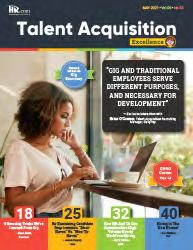
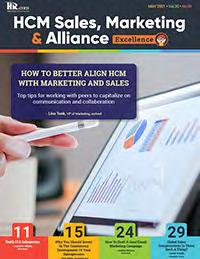


 Winkle
Winkle
I regularly read and contribute to Leadership Excellence and Talent Management Excellence. I use many of the articles I read to augment my own presentations and I often share the articles with my clients. They are always quick, right on target for the latest issues in my field, and appreciated by my clients. If you want to stay up to date on the latest HR trends, choose a few of the different issues from the Excellence series of publications.



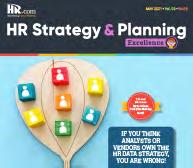
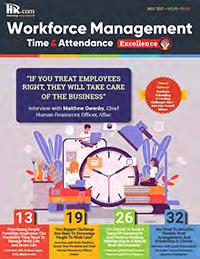


We’re eager to hear your feedback on our magazines. Let us know your thoughts at ePubEditors@hr.com

 Rensis Likert Professor, Ross School of Business, University of Michigan Partner, The RBL Group
Rensis Likert Professor, Ross School of Business, University of Michigan Partner, The RBL Group
WHY EXCELLENCE PUBLICATIONS?
Julie
Giulioni Author, Virtual /Live Keynote Presenter, Inc.’s Top 100 Leadership Speakers
Dr. Beverly Kaye CEO, BevKaye&Co.
Why American Employers Should Explore New Ways To Offer Family-Forming Benefits
The impact of the Covid-19 baby boom
By Dr. G. David Adamson, ARC Fertility
Inthe aftermath of the Covid-19 pandemic, a surprising demographic change has emerged: a mini baby boom. According to the National Bureau of Economic Research, U.S. fertility rates unexpectedly surged by 6.2% in response to the pandemic after a 15-year decline, signaling that a sizable portion of the working population found the opportunity to expand their families. With the World Health Organization recently declaring the end of Covid-19 as a global health emergency, it’s worth considering how transformed workplace norms may continue to affect family-forming trends.
New Work Models, Growing Families
Before the advent of hybrid and remote work models, many potential parents were deterred by the prospect of juggling a demanding job and raising children. Now, with the flexibility to adapt their work schedules around family needs, this barrier is less daunting.
Employees can simultaneously build their families and grow their careers. Less time spent commuting, more flexibility in working hours, and an enhanced work-life balance have made the prospect of familybuilding more feasible.
For Top Talent, Offer Better Benefits
The pandemic has also reminded employees and employers of the importance of well-being, which includes people’s personal lives and family aspirations. Companies must respond and adapt their benefits packages accordingly, recognizing that comprehensive reproductive health benefits contribute greatly to an employee’s wellness.
Fertility coverage is quickly becoming more than a nice-to-have — it’s a business necessity. Traditional compensation methods like salary and healthcare alone are no longer sufficient for retaining top-tier talent. As companies face the challenges of an increasingly competitive labor market, they must revisit their benefits packages with a more inclusive lens.
As it stands, the federal government has no minimum coverage guidelines for reproductive health benefits, such as in vitro fertilization (IVF), surrogacy, and adoption. Inclusive benefits packages set a company apart from its competitors by demonstrating a commitment to their employees’ personal fulfillment, ultimately boosting company morale and attracting quality candidates.
Employee Benefits & Wellness Excellence presented by HR.com July 2022 7 Submit Your Articles
COVER ARTICLE
Prioritizing comprehensive fertility benefits can contribute to better business outcomes. By taking care of their employees’ needs, companies may see improved employee satisfaction and increased workforce loyalty. Ultimately, companies offering coverage for their employees will have a more productive workforce, reduced turnover, and a more positive corporate image.
Fertility Perks Are DEI Perks
Companies can also work toward their diversity, equity, and inclusion (DEI) goals by offering reproductive health coverage. Fertility treatment is not a one-size-fits-all solution but rather a highly individualized process that varies greatly based on a person’s or family’s specific needs.
For example, a couple both assigned male at birth might require a surrogate carrier, in vitro fertilization, and egg donation. For trans individuals, fertility benefits might include surrogates, donors, and egg or sperm preservation before gender-affirming procedures.
Recognizing employees’ diverse needs and providing coverage for a wide range of treatments is the first
step toward creating a truly inclusive workplace. By extending benefits that cover a range of fertility treatments and family-building options to all workers, companies send a clear message: every employee — regardless of family status, gender, or sexual orientation — is valued and supported in their familybuilding journey.
How to Make Family-Forming Benefits More Affordable

But the demand for comprehensive and inclusive fertility benefits leads to a different issue: affordability. Offering such benefits through traditional health insurance can be expensive for employers. However, the market is responding with flexible alternatives that are financially viable and meet the wide-ranging needs of diverse employees.
Companies can look for healthcare organizations that allow them to select and pay for the level of benefits they can afford to provide. This flexibility ensures that a broader range of employees can access the care they need without imposing undue financial strain on the employer.
Employee Benefits & Wellness Excellence presented by HR.com July 2022 8 Submit Your Articles
Why American Employers Should Explore New Ways To Offer Family-Forming Benefits
For instance, a company might opt to cover several rounds of IVF treatments or include coverage for surrogacy and adoption. Alternatively, a smaller business might choose to cover a percentage of the cost of these treatments.
This pay-as-you-go approach offers a scalable solution. Employers can tailor their reproductive health benefits to their budgetary constraints, ensuring sustainability while still supporting their employees. Moreover, this model democratizes access to fertility treatments, making them feasible for employees regardless of their income or family status.
Such financing options contrast with traditional health insurance plans that often come with high costs and inflexible terms. This innovative approach allows for inclusivity and customizability, ensuring that employers of all sizes can provide benefits that genuinely support their employees’ family-building journeys.
Companies offering flexible financing options for both employers and employees provide an excellent model. By designing packages that contrast with traditional health insurance plans, they ensure that a broader range of people can access the care they need. Regardless of marital status, employees can receive the necessary support to start or grow their families.

Adapting for a Better Future
The post-Covid-19 world has demonstrated the importance of adaptability. We must now ensure that this adaptability extends to how we approach employee benefits, making them better suited to support everyone’s path to parenthood. By embracing inclusive fertility benefits, American employers can support their employees in the most profound way — helping them pursue fulfilling lives outside of work. This, in turn, will contribute to a happier, more diverse, and ultimately more successful working world.
Dr. G. David Adamson , MD, FRCSC, FACOG, FACS, is the Founder, Chairman, and CEO of ARC Fertility. He is a globally recognized reproductive endocrinologist and surgeon and is a Clinical Professor, Adjunct Clinical Faculty at Stanford University, and Associate Clinical Professor at UCSF. Dr. Adamson also serves as the current Chair of the International Committee Monitoring ART (ICMART), a WHO NSA/NGO.
Would you like to comment?

Employee Benefits & Wellness Excellence presented by HR.com July 2022 9 Submit Your Articles
Why American Employers Should Explore New Ways To Offer Family-Forming Benefits
Fertility Benefits In The Workplace: The Great Confrontation And The Quest For Top Talent
Aligning with DEI and ESG principles to attract top talent
By Liz Pittinger, Stork Club
Several major publications have recently released stories about benefits policies. This publicity isn’t necessarily for good reasons. For example, in January, Twitter CEO Elon Musk made headlines when he slashed the company’s benefits package, eradicating fertility benefits like in vitro fertilization (IVF), adoption sponsorship, and egg freezing. Hundreds of Twitter employees who previously relied on financial assistance to access fertility services were left to pick up the pieces.
The war on benefits doesn’t stop at Twitter. Why are these offerings the first victims of downsizing during challenging economic times? The answer to this question is nuanced and
complicated — just as complex as the history of benefits in the workplace. For many, it boils down to the perception that certain benefits are nice to offer but not a must-have.
Until recently, many decisionmakers regarded fertility and other family-building solutions as fringe benefits. However, the last decade has transformed the workforce. Countless employees have adopted a new view on work-life balance and productivity, leading to updated expectations for human resources (HR) departments. Now, when an employer misses the mark, employees are far more willing to quit and find better accommodations. Some may call
this the Great Resignation; I refer to it as the Great Confrontation.
Top talent is a hot commodity, and employees are willing to consider better offers. Yet that also means current employees could choose to leave under the right circumstances. HR leaders must balance attracting external talent and incentivizing top performers to stay. SHRM estimates the cost of replacing an employee is up to 200% of the departing employee’s salary, making it easy to understand why retention is a top priority across all organizations. And companies with a strong diversity, equity, and inclusion (DEI) strategy typically outperform those without in terms of revenue, market share, and retention.
Employee Benefits & Wellness Excellence presented by HR.com July 2022 10 Submit Your Articles
Top Pick
Many factors contribute to a positive and meaningful work environment. However, impactful incentives like family-building benefits are singular in their ability to make an outsized difference in the decisions of prospective and current employees. Here is why yesterday’s “nice-to-have benefits” have become so mission-critical for both retaining employees and supporting the company’s overall growth and profitability.
Quality Reproductive Care Is Life-Changing
Benefits have an indelible effect on employees’ lives. We understand this in the context of traditional offerings like healthcare insurance because, at one point or another, we’ve all relied on these solutions to pay for a steep medical bill or provide a loved one with a check-up or
surgical procedure. Now, consider that infertility in the U.S. outpaces chronic disease and maternal mortality rates in all other industrialized nations.
When do women typically leave the workplace? When they have a baby or when they reach menopause. If you aren’t supporting women at these key moments in their professional careers, ask yourself: Is your DEI strategy robust enough?
From reproductive healthcare options to hormone replacement therapy, family-building benefits can change lives and significantly impact retention for critical members of your workforce. For example, a woman is 50% more likely to quit her job after having a baby if she has to pay for fertility treatments out of pocket.

However, when the organization covers fertility treatments, she is 88% more likely to return to work
And how do traditional healthcare plans support Black employees? Not only are Black women two times more likely to experience infertility, they are three times more likely to die from childbirth-related complications compared to White mothers. To address the complications of childbirth for BIPOC members, look no further than doula care. High-quality and culturally sensitive doula care is proven to improve pregnancy outcomes for expectant Black mothers. This is evidenced by a reduction in the number of C-sections rendered, an increased percentage of full-term births, and lower rates of postpartum depression.
Employee Benefits & Wellness Excellence presented by HR.com July 2022 11 Submit Your Articles
Fertility Benefits In The Workplace: The Great Confrontation And The Quest For Top Talent
Family-building benefits provide birthing persons access to this high-quality and life-changing — even life-saving — care. Without their employer’s benefits package, many birthing persons would often not have access to doula care (or other reproductive offerings like postpartum care and back-to-work coaching).
That is because, unfortunately, the costs associated with some family-building solutions place them out of the reach of employees paying out-of-pocket. Consequently, vital but non-medically necessary options like fertility therapy are ignored.
Birthing persons — and their partner, if relevant — experience higher rates of isolation, depression, and anxiety as a result.
On the other hand, employees with access to family-building benefits are healthier, happier, and more productive. These employees also experience less stress related to financial burden, which remains a leading cause of workplace anxiety. By providing these offerings, employers alleviate their employees’ concerns related to family, health, and finances, allowing them to satisfy and exceed their daily responsibilities.
Benefits Must Evolve to Meet the Needs of the Modern Workforce
Times are changing. On a micro-scale, we’ve witnessed a shift toward operations-focused expenditures in response to inflation and rising interest rates. But on a macro level, much more significant changes have occurred in our daily working environments. The eldest of Gen Zers have entered the workforce. Beyond that, many organizations have chosen to align with new and improved environmental, social, and governance (ESG) principles because the economic data shows that’s good business.

Employee Benefits & Wellness Excellence presented by HR.com July 2022 12 Submit Your Articles
Fertility Benefits In The Workplace: The Great Confrontation And The Quest For Top Talent
Simultaneously, young professionals overwhelmingly value their organization based on commitments to DEI and ESG. In fact, 76% of job seekers say workplace diversity is integral to their decision to take a job. And many of these prospective applicants seek genuine commitments to an inclusive workplace instead of workplace platitudes. The result? Workplaces creating an equitable environment for all employees will win out in the search for top talent.
Notably, many family-building solutions are relevant for diverse populations. For example, although single parents and straight couples frequently use IVF treatments, it’s an especially vital offering for LGTBQ+ individuals. More than half of LGTBQ+ millennials (63%) plan to have children with the help of assisted reproductive technologies. Other popular forms of conception for LGBTQ+ individuals include surrogacy and adoption, also covered by leading family-building programs.
Many of us, not to mention many of our colleagues and friends, belong to the LGBTQ+ community. Yet traditional benefit offerings have lagged in accommodating LGBTQ+ parental journeys. Consider that the average IVF cycle costs more than $30,000, and most parents-to-be require multiple cycles to become pregnant. This creates an undue financial burden on all employees undergoing IVF.
The price tag of IVF treatments is enough to dissuade prospective applicants from accepting an offer at an organization without familybuilding benefits. Organizations that refrain from offering these benefits foster a less inclusive environment where employees feel unheard and undervalued — especially diverse employees. And in the modern workforce, this environment is unacceptable.
Moreover, family-building solutions go a long way toward alleviating environmental and sociological factors that influence employees’ well-being and health. These factors, known as the social determinants of health (SDoH), include environmental surroundings like neighborhood and social/community context as well as social factors like economic stability and access to education. By making an effort to understand their employees’ distinctive SDoH, employers can provide a more beneficial and tailored benefits package that allows employees of all backgrounds to enjoy equitable access to healthcare.
How to Select Benefits that Reflect Well on Your Organization
Keep your organization’s HR offerings from making news for the wrong reasons. Slashing or neglecting family-building benefits is a genuinely fatal error. After all, consolidated coverage platforms for family-building offerings offset the coverage costs for employers, which can actually lower benefit costs over time.

When considering which suite of benefits to offer your employees, use your organization’s ESG and DEI targets as a guiding light. Doing so will ensure that your benefits package aligns with the organization’s mission and caters to the preferences of current and future employees.
It’s also critical to consider organization-specific factors. For example, fully remote offices may benefit from geographically non-specific benefits like travel reimbursement, which covers the costs of travel to medical services located outside their jurisdiction.
The key to success with benefits is to offer comprehensive solutions that allow your employees to be seen, heard, and understood. In 2023, that undoubtedly includes familybuilding solutions. And do not let competitors fool you — organizations that drop family-building solutions are falling behind in inclusivity. As a result, they’re losing the highly competitive race for top talent. And that’s a cultural loss that will be difficult to rebuild.
Employee Benefits & Wellness Excellence presented by HR.com July 2022 13 Submit Your Articles
Liz Pittinger is the Head of Customer Success at Stork Club .
Would you like to comment?
Fertility Benefits In The Workplace: The Great Confrontation And The Quest For Top Talent
Digital Wellness – From a Scaffold to a Pillar of Employee Well-Being

The HR Research Institute, powered by HR.com
Introduction
What is our level of digital wellness? This is an increasingly key question not only for ourselves and loved ones but for the employees in our organizations. In an era of rapid technological advancement and an increasing prevalence of digital devices, this new dimension of well-being has emerged. Digital wellness focuses on fostering a positive relationship with technology to promote the overall welfare of employees.
Today there are 5.16 billion Internet users in the world and 5.44 billion unique mobile phone users, according to the report Digital 2023. The average
time spent using the Internet is 6.37 hours globally, and the average American spends nearly 7 hours looking at a screen per day. In short, we expend many of our waking hours on the Internet and looking at screens.
Of course, this greatly impacts our physical, mental, and social well-being. Extended periods of sitting and decreased physical activity due to technologyrelated tasks often lead to a sedentary lifestyle and associated health risks. The constant exposure to information and notifications can lead to stress, distraction, and reduced focus, impacting employee productivity and well-being.
About the Research
In this article, we allude to data from the HR Research Institute’s survey on Digital Wellness that was fielded in 2023 in partnership with McAfee, the global computer security software company. The survey had 204 respondents from a wide range of industry verticals, all of them being HR professionals from large organizations (at least 1,000 employees) in the United States.
14 ARTICLE
What’s more, all this time spent on digital technologies has massive implications for the security of our employees and the wider organization. These security issues can, in turn, impact everything from mental to financial wellness.
A Brief History of Wellness in the Workplace
Employee wellness is not a new concept, but it is one that has been evolving quickly.
Wellness and well-being programs date back to the mid-20th century, when employers began recognizing the impact of employee health on productivity and overall organizational success. Initially, in the 1950s and 60s, the emphasis was primarily on occupational health and safety programs, with a focus on preventing workplace accidents and injuries.
As we entered the 1970s and 80s, employers realized that promoting preventive measures and encouraging healthy behaviors among employees could lead to reduced healthcare expenses in the long run. HR departments started emphasizing wellness initiatives that focused on areas such as increasing cardio health, helping people stop smoking, and encouraging regular physicals. During the 1990s, well-being programs expanded further to include stress management, work-life balance, and employee assistance programs (EAPs) to support mental and emotional health.
a more holistic approach that covers not only physical and mental health but also social, financial, environmental and now digital wellness. The idea is to look at overall employee well-being and help improve it where possible.
Defining Digital Wellness

For the purpose of the survey we conducted, we defined a healthy state of digital wellness as being when people are protected from weak spots in their digital security, their privacy is protected, and they are in control of their personal data. It also often means they have a healthy, non-addictive relationship with technology.
Boston Children’s Hospital’s Digital Wellness Lab defines it as a positive state of mental, physical, and social-emotional health pursued through intentional, authentic, and balanced engagement with technology and interactive media.
Factors Making Digital Wellness More Critical
There are a variety of factors making digital wellness increasingly critical. Although each one is important, they tend to influence one another in a systemic way.
Physical and Mental Issues Related to Digital Habits
In the 21st century, the focus of well-being programs has expanded and shifted towards
Excessive screen time and sedentary behavior associated with technology use can lead to physical health issues such as eyestrain, musculoskeletal problems, obesity, and sleep disturbances. It can also cause decreased interpersonal interactions and feelings of isolation.
15 ARTICLE
When people spend hours engaged in social media on their smartphones, digital addiction becomes a real concern. Excessive reliance on technology and constant connectivity can negatively impact productivity, relationships, and overall well-being. Moreover, identity theft, data ripping, clickbait, and phishing scams make employees anxious and add to existing work pressures.
Costly Security Concerns
Indeed, various online security concerns seem more daunting by the day. The consulting firm McKinsey & Company, for example, reports that “mobile platforms, remote work, and other shifts increasingly hinge on high-speed access to ubiquitous and large data sets, exacerbating the likelihood of a breach.” It also reports that amid

these changes, many organizations lack sufficient cybersecurity talent, a shortfall that is increasing.
These online security concerns can have a large impact on employee well-being. Our study of HR professionals found, for example, that over 80% of respondents say that employees are concerned or very concerned about identity theft. A majority of them are aware of employees who have experienced identity theft, and many see fear about financial safety (58%) and reduced work performance (54%) as potential outcomes of such theft.
We also learned that 6 in 10 responding organizations have had cybersecurity breaches due to employee error and, among those, 53% resulted in financial losses.
16 ARTICLE
The Rise in Remote Work and Personal Device Usage
The COVID-19 pandemic prompted a shift to remote and hybrid work arrangements, and it increased the prevalence of digital nomadism. In our survey, more than half of organizations agreed that remote work has reinforced the importance of digital wellness.
Moreover, working remotely or not, many employees are using personal devices for work purposes. Indeed, our study also showed that in 70% of organizations, at least half of employees use personal devices for work purposes.
These trends are complicating the issue of digital wellness and security.
The Rise in Generative AI
The public release of OpenAI’s ChatGPT and other generative artificial Intelligence (AI) applications has already heightened concerns about employee digital security and wellness.
Increasingly, hackers are using AI to automate attacks and evade detection systems. Dark Web forums are reportedly full of discussions on how to use generative AI platforms to execute phishing and social engineering attacks.
Many fear AI will also be used to create “deepfakes” that will enable bad actors to more successfully engage in identity theft and other crimes.
against cyberattacks, phishing attempts, or online harassment.
The Advantages of Digital Well-Being as an Employee Benefit

Given the rising importance of these and other factors, we believe that employee benefits aimed at boosting digital wellness will become increasingly attractive to employers and employees alike. In our study, when we asked about which benefits employees value the most apart from medical benefits, we found that digital wellness was highly ranked, second only to retirement benefits.
We view digital wellness as complementary to other benefits, including physical and mental health benefits.
Digital workers often struggle with setting boundaries, managing screen time, managing their own digital security, and disconnecting from work. By providing digital well-being support, organizations can help employees maintain a healthy work-life balance, improve productivity, and prevent burnout.
This can enhance employee recruitment and retention, particularly among younger generations who are more tech-savvy and seek healthy work-life integration.
Of course, over time, AI applications can also be useful in improving cybersecurity. AI algorithms can detect potential security breaches, identify malicious activities, and offer real-time protection
In fact, our study shows that, to a high or very high degree, HR professionals at large organizations believe that digital wellness solutions are effective tools for enhancing cybersecurity (94%), helping with retention (87%), and improving safety and wellbeing (86%).
17 ARTICLE
Survey Question: Apart from medical benefits, which of the following benefits do you think are most important to employees in your organization? (select all that apply)
Retirement plans (e.g., 401k, pension plans)
Digital wellness (e.g., identity theft and cybersecurity protection)

Career development (e.g., paid conferences, cer tifications, training)
Life insurance
Financial education and counseling
Disability insurance
Retail discounts
Legal services
Gym memberships
Student loan repayment assistance
Pet insurance
18 ARTICLE 0 10 20 30 40 50 60 70 80 80% 71% 67% 61% 53% 42% 29% 28% 20% 17% 8%
Developing Greater Employee Digital Wellness

But exactly how can employers boost the digital wellness of their employees? Following are some recommendations. These are far from allencompassing but may help an organization get started.
● Offer digital wellness support and services. Among the services most widely cited in our survey are:
o Using applications that defend against malware/viruses
o Knowing how to remove malware from infected devices
o Using virtual private networks (VPNs) that encrypt unsecured Wi-Fi networks
o Knowing how to avoid unsecured Wi-Fi networks
o Creating strong and unique passwords
● Educate. Teach employees about digital security and wellness. For example, train them to be cautious about the websites they visit, the apps they download, and the information they share online. Being proactive is essential when it comes to the digital world because the costs don’t just stop at money. They extend to mental strain and emotional burnout.
● Teach mindful awareness. Employees should be intentional about how, when, and why they use digital devices. To avoid burnout, they can set clear boundaries around technology use, especially during certain times of the day or in specific areas of their lives.
● Ensure EAPs can help struggling employees. Employee Assistant Programs can typically help employees cope with a variety of stress and addiction issues. Internet addiction disorder should be something they can help with.
● Offer digital wellness resources. These can assist employees in managing screen time, protecting data and privacy, and maintaining a healthy relationship with technology.
Conclusion
Digital well-being has emerged as a critical consideration in today’s technology-driven world. As individuals become increasingly connected and reliant on digital devices, it has become necessary and crucial to recognize the impact of technology on our physical, mental, and emotional well-being. As new technologies such as generative AI and virtual reality devices become more common, the need for digital well-being will grow in importance. Organizations need to recognize the significance of digital well-being as an employee benefit alongside traditional offerings. By prioritizing and successfully enhancing digital well-being, organizations can help attract and retain talent, improve productivity, and demonstrate their commitment to supporting holistic employee well-being.
Would you like to comment?
19 ARTICLE
Complete Digital Peace of Mind. For Employees. For You.
All-in-One Digital Wellness Benefits from McAfee
Identity, privacy and award-winning device protection during work time and play-around time.
Keeping your employees safe online is our full-time job.

Learn more
Learn more
Popular Workplace Demands 2023: Menopause Leave Tops The List
Unveiling employee priorities in an evolving landscape
By Bradford Goodwin, Lensa
Ina rapidly evolving work landscape, the expectations and demands of employees are constantly shifting. To gain valuable insights into the trending employee demands of 2023 and the most popular workplace demands on a global scale, Lensa conducted an extensive research study
By analyzing the number of annual searches surrounding workplace demands, the study aimed to identify the demands that are currently on the rise and resonate with employees worldwide.
Topping the list at the number one spot is “Menopause Leave.” This demand has experienced a remarkable surge of 336% in the past year.
Earlier this year, the rejection of a proposal for a menopause leave trial by ministers in the UK sparked significant criticism from the Women and Equalities Committee. The lack of support for women in the workplace experiencing menopause symptoms is evident., Although some companies, such as Modibodi in Australia and the Bank of Ireland, have taken progressive steps by offering menopause leave.
However, the concept is yet to be widely adopted by countries globally.
Securing the second position is “Mental Health Support in the Workplace.” The unprecedented challenges brought forth by the Covid-19 pandemic have resulted in a 25% increase in the prevalence of mental illnesses, including depression, reported by the World Health Organization. Consequently, there has been a substantial 150% increase in searches for workplace mental health support over the past year. This significant rise underscores the urgent need for organizations to establish comprehensive support systems to address the mental well-being of their employees.
Further highlighting the growing interest in greater flexibility, the “4-Day Work Week” demand ranks third among the globally trending employee demands. This demand has experienced an impressive 82% increase in search volume in the past year. The concept of a shorter workweek has gained traction as employees seek improved work-life balance and enhanced flexibility in their professional lives.
Submit Your Articles Employee Benefits & Wellness Excellence presented by HR.com JUNE 2023 21 Top Pick
In addition to the top three demands, the study also identified other noteworthy trending demands. “Office Socials” ranked fourth, reflecting the desire for more opportunities for socialization and team building within the workplace. “Faster Hiring Process” secured the fifth spot, indicating the increasing impatience of job seekers and the need for streamlined and efficient hiring practices.
“Workplace Boundaries” ranked sixth, reflecting the growing importance of maintaining a healthy separation between work and personal life. “Modern Workplace Technology” and “Sustainable Workplace Practices” shared the seventh position, emphasizing the rising interest in technological advancements and environmentally conscious practices in work environments. The remainder of the top 10 workplace wishes got as specific as “Pet-Friendly Offices,” “Ergonomic Office Furniture,” and “Office Coffee Machine”.
While the trending employee demands provide valuable insights into the changing expectations, it is equally crucial to understand the most popular workplace demands on a global scale. Topping the list of popular demands from employees worldwide is “Remote Working,” with an impressive annual search volume of 1,911,000. The value placed on flexibility in the workplace is evident as employees
seek opportunities to work remotely and maintain a work-life balance. Following closely behind is “Work-Life Balance,” with approximately 1,890,000 annual searches, further underscoring the significance of a harmonious integration of work and personal life.

Corporate social responsibility takes the third spot among the most popular workplace demands. The term has witnessed a considerable 1.69 million global Google searches over the past year, signifying that employees prioritize employers who align with their values and ethics.
From menopause leave to pet-friendly offices, it is clear that employees know what they want from the workplace in 2023. With the right matchmaking in the recruitment process, there are companies and jobs that can meet a whole host of specific wants and needs.

Employee Benefits & Wellness Excellence presented by HR.com July 2022 22 Submit Your Articles
Popular Workplace Demands 2023: Menopause Leave Tops The List
you like to comment?
Bradford Goodwin is a Content Strategist at Lensa
Would
What Goes Up Must Come Down
How to understand and mitigate stress among remote and hybrid workers
By Edward J. Beltran, Fierce Conversations
Inthe years since the Covid-19 global pandemic, employees and employers alike have begun to seriously address issues surrounding mental health and employee well-being in the workplace. Unfortunately, the rapid implementation of remote work rendered inadequate many of the tools and systems we long relied on to address employee well-being. While it may seem to have been a paradigm-shifting moment, the workplace changes caused by the pandemic simply brought to light underlying problems.
Many of the tools and systems we relied on previously were, to be blunt, not getting the job done. Relying on employees to speak openly with managers about what negatively impacts their job performance requires a level of trust and openness few businesses have achieved.
Furthermore, to the extent that such conversations were taking place, they relied on a level of closeness not so easily attained in remote office spaces. In fact, a recent study found that when compared with in-office employees, remote and hybrid workers are more likely to experience depression and anxiety symptoms
It’s Not Me, It’s You
When it comes to workplace stress, nearly eight in ten workers say they expect management to take the lead
in managing workplace stress, with 55% reporting their employer is not doing enough to help. However, managers are faced with the task of building a plane while already in the air. Furthermore, the managers have no instruction manual to help them navigate, as efforts to mitigate anxiety fell short even before the pandemic. Working with tools designed for an entirely different work environment, it is no small wonder employees feel managers are falling short.
Additionally, increased depression and anxiety result in decreased productivity. Seeing this, employers often seek to tackle these issues from a top-down way. While well-intentioned, these initiatives often paint with too broad a brush. Employers must understand the different stressors faced by their workers in order to overcome them. As some major employers have no plans to require employees to come back to the office, any solution to this problem must help remote and in-office workers alike.
Me, Myself, and My Screen
Part of the problem for in-office and remote workers stems from difficulty pinpointing exactly what their stressors are. When seeing each other daily, employees will be better able to relate with colleagues over shared stressors, and supervisors will have more opportunities to observe and understand those anxieties. However, the nuances of interactions do not always come through in a direct message or video call.
Employee Benefits & Wellness Excellence presented by HR.com July 2022 23 Submit Your Articles
Many of the problems faced by remote workers, as with workplace stressors writ large, existed long before the pandemic. These stressors were simply exacerbated by the rapid workplace changes. Even in an environment of full honesty and transparency, workplace stressors will remain. The key comes down to understanding what those stressors are. Wherever we are working, we are not always the most reliable narrator. Only by recording when we experience stress, whether working from home or working in-office, can we begin to understand our stressors.
As Easy as Checking Your Pulse
A deeper understanding of individual stressors seems obvious, but if it were that simple, why haven’t we done it yet? Tailoring mental health programs for all employees to their own individual stressors seems easier said than done, but with the resources available today, that is no longer the case.
While we may not fully understand our stressors, our body doesn’t lie. Using the very wearable technology already prevalent among office workers, you can
now track physiological stress reactions, creating a roadmap of your stress. However, while some use wearable tech to track step counts, relatively few employees use wearable technology for such workplace monitoring, meaning nearly all of us rely on unpredictable means of understanding our stressors. With such poor maps, it is no wonder we have not gotten where we want to go.
By tracking biometrics and connecting that data with GPS and calendar data from the smartphones ever-present by our sides, we can create the map we need. We can see where we were when we experienced increased stress. These can be combined to help users glean insights based on that information about when they or where they were stressed, for example, advice on how to have a conversation about proper workload or preferred communication styles. The vast majority of employee-related stressors come down to breakdowns in communication, so pinpointing when and where those breakdowns occur is vital.
Employee Benefits & Wellness Excellence presented by HR.com July 2022 24 Submit Your Articles
What Goes Up Must Come Down
Additionally, such data could potentially help employers better understand the stress experienced by their workers. By analyzing breakdowns of stress among various groups of employees - between remote and office workers, for example, or how stress levels change from in-office to remote work for hybrid employees - executives can integrate wearable tech into employee wellness programs.

We Are All in This Together
These insights empower employees to gain a deeper understanding and mitigate stressors individually while helping businesses implement programs tailored to the specific wants and needs of their employees. This understanding enables workers and managers to tackle stress issues collaboratively rather than separately. When able to have a hand in mitigating their own stress, employees can better determine the work-life balance, and home-remote balance, that best suits them. This leads not only to improved employee well-being but improved business outcomes as well.
Edward J. Beltran is the CEO of Fierce Conversations , a communication and leadership training space. According to Beltran, the days of the singular approach to leadership/ communication training focused on in-person training are gone forever. Leaders and their teams now need a suite of dynamic tools that help them better meet their daily challenges. This philosophy led to the creation of the Pulse By Fierce app, a tool to help reduce the $300 billion lost annually due to employee stress.
Would you like to comment?

Employee Benefits & Wellness Excellence presented by HR.com July 2022 25 Submit Your Articles
What Goes Up Must Come Down
HRCI® & SHRM® CERTIFICATION PREP COURSES
GROUP RATES AVAILABLE
For HR Professionals
Show that management values the importance of the HR function, and has a commitment to development and improvement of HR staff.
Ensure that each person in your HR department has a standard and consistent understanding of policies, procedures, and regulations.
Place your HR team in a certification program as a rewarding team building achievement.
For Your Organization
Certified HR professionals help companies avoid risk by understanding compliance, laws, and regulations to properly manage your workforce.
HR Professionals lead employee engagement and development programs saving the company money through lower turnover and greater productivity and engagement.
A skilled HR professional can track important KPIs for the organization to make a major impact on strategic decisions and objectives, including: succession planning, staffing, and forecasting.
HR.com/prepcourse CALL TODAY TO FIND OUT MORE 1.877.472.6648 ext. 3 | sales@hr.com
1 Less expensive than a masters or PhD program, and very manageable to prepare with
2. legislation and best practices
3. Recognized, Industry benchmark, held by 500,000+ HR Professionals
Group Rate Options
We offer group rates for teams of 5+ or more for our regularly scheduled PHR/SPHR/ SHRM or aPHR courses.
For groups of 12+, we can design a more customized experience that meets your overall length of the course.
Groups rates for HRCI exams are also available as an add-on.
All group purchases come with 1 year of HR Prime membership for each attendee to gain the tools and updates needed to stay informed and compliant
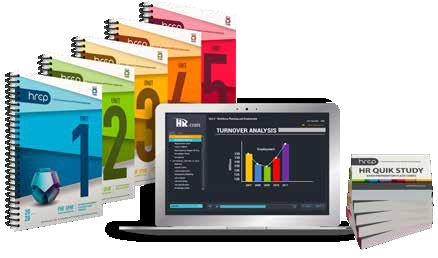
CALL TODAY TO FIND OUT MORE 1.877.472.6648 ext. 3 | sales@hr.com | HR.com/prepcourse
1 2 3
From Burnout To Balance: How Companies Can Fully Support Workforce Well-Being

The current state of employee mental health
By Neil King, TELUS Health
The 2020s have been a challenging decade thus far. The Covid-19 pandemic, political, social, and racial unrest, and the
climate crisis have all set a dark cloud on top of the everyday ups and downs we each experience. And, as much as employees might
try, it’s nearly impossible to check your stress at the door when you arrive at work.
The TELUS Mental Health Index (Index) conducted in April 2023 unveiled a distressing reality: three out of five U.S. workers were at moderate or high risk of developing a mental health condition such as addiction, anxiety, or depression. And for those who do develop one of these conditions, the issue is often exacerbated by a nationwide shortage of mental health providers; the federal government estimates that more than 100 million individuals live in areas that lack access to adequate care. So perhaps it’s not surprising that a recent survey by the meditation app Calm found that two-thirds of working adults said they wanted their employer to help them take care of their mental wellness.
Employee Benefits & Wellness Excellence presented by HR.com July 2022 28 Submit Your Articles
Top Pick
In the same survey, employers expressed an overwhelming desire to provide more comprehensive mental health benefits, with nearly 90 percent stating that boosting these benefits was among their top priorities. Recent workplace trends such as the Great Resignation and quiet quitting show that employees are increasingly leaving jobs due to mental health reasons. Another 2021 survey found that a majority of Millennials (68 percent) and Gen Zers (81 percent) had left roles due to factors like overwhelming and unsustainable workloads.
Policies and Training
While the impetus lies with the employee to seek care, employers are recognizing that initiatives and benefits that support a worker’s mental well-being at work, as well as outside of it, bring benefits to the bottom line in terms of
productivity, reduced attrition, and a happier workforce. For these reasons and more, companies are increasingly offering expanded benefits and other programs to support the mental well-being of their employees.

In the workplace, new policies and procedures have also been established to ensure that all employees feel supported. Zero-tolerance policies on violence and all forms of harassment in the workplace that apply to all employees, contractors, customers, and anyone else who comes in contact with company personnel are a first step. These include compliance with any federal or state laws protecting employees diagnosed with post-traumatic stress disorder (PTSD), depression, or other mental health conditions.
Additionally, mental health awareness training (MHAT)
teaches managers how to identify, understand and respond to signs of potential mental illness or substance use disorders in the workplace, how to discuss the issue without stigmatizing the employee, and how to cultivate resilience to reduce potential burnout.
Expanded EAP and Other Benefits Plan Supports
In addition to mental healthcare insurance, nearly 8 in 10 employers offer Employee Assistance Programs (EAP), which have traditionally been an underutilized benefit. EAPs are benefit programs that help workers with problems that might impact their job performance or their health and mental well-being. These voluntary programs offer confidential assessments, short-term counseling, and referrals to services such as financial planning, legal counsel, dependent care, and more.
Employee Benefits & Wellness Excellence presented by HR.com July 2022 29 Submit Your Articles
From Burnout To Balance: How Companies Can Fully Support Workforce Well-Being
During the pandemic, more people - especially womentook advantage of the medical and mental health referrals and consultations offered through EAPs. Today, with a greater acceptance of telemedicine and app-based wellness, tools such as self-directed online cognitive behavioral therapy (CBT) and other forms of psychotherapy have become available to those in regions underserved by mental health professionals.
A 2020 workplace outcome report found that the return on investment (ROI) for EAPs can reach as high as 9 to 1 for large organizations; smaller employers can see an ROI of three to five times their investment. Additionally, the survey found that EAPs had the potential to save companies as much as $3,500 per case in lower absentee- and presenteeism.
And beyond EAPs, other mental health services provided through benefits plans can play a part. Many companies now offer comprehensive mental health support available to users any time of the day in multiple formats – virtual, phone, or in-person. Some services also provide dedicated care navigators who help employees better manage their journey and are with them every step of the way as they access counseling. There are a host of other virtual health innovations enabling employers to lead the way to better total health and well-being for employees.
Support for Physical Health
According to the American Psychological Association (APA), a person’s physical health can correlate to their mental health. The April Mental Health Index found that workers who reported good physical health had an average mental health score of 81.8, nearly 12 points higher than the national average. Conversely, 8 percent of workers reported poor physical health or significant physical health challenges, with 34 percent of them stating their employer is aware of the physical health issue but has not been helpful in supporting their management of it.
A lack of exercise and quality sleep also impacts workers’ mental health. The Index found that most workers exercise less than 90 minutes a week; those who reported at least 3.5 hours of strenuous exercise tallied better mental health scores. Although these issues are not directly related to the workplace, employers can support workers through comprehensive workplace health and safety (CWHS) programs that protect physical and psychological health.
These programs include enabling adequate rest and time off, for example, not scheduling a retail worker to open the store the day after working until close, enabling flexible work schedules, and empowering managers and supervisors to encourage their
reports to take breaks throughout the day. For some employees, just knowing they can take a 15-minute break to walk around the block is enough to reduce their stress levels.
There has never been a time when employees’ willingness to use mental health support has been this high. Employers can either seize the opportunity to prioritize employee mental health to create a healthier, more engaging, and more productive workplace or risk the serious business impacts of an unhealthy workforce.
Personally, I’d much rather be a part of an organization that is focused on building a future where mental health is valued and supported, and I’m willing to bet your employees are too.
Neil King is the Managing Director for Employer Solutions at TELUS Health . His responsibilities include global responsibility for EAP, Well-being, Student Support, and Training Solutions.
Would you like to comment?

Employee Benefits & Wellness Excellence presented by HR.com July 2022 30 Submit Your Articles
From Burnout To Balance: How Companies Can Fully Support Workforce Well-Being
Just Say ‘No’ To Toxic People
Common toxic behaviors to watch out for
By Ken Keis, Ph.D., Consulting Resource Group International, Inc. (CRG)
Strife: Bitter, sometimes violent conflict or dissension; an act of contention; exertion or contention for superiority
Toxic: Containing or showing poisonous material or content; extremely harsh, malicious, or harmful, e.g., toxic sarcasm
What Are Toxic People Costing You?
There’s a saying that you become like the books you read, the TV/media you watch and read, and the company you keep. That holds true for everybodyyour family, friends, co-workers, clients, and suppliers. The people around you have a significant impact on your well-being and success. Do they build you up and encourage you, or do they discourage and drain you?
It’s essential to take responsibility for your personal space and relationships in life, as doing nothing can allow toxicity to seep into your life.
I have little time or patience for toxic people – (now called the Karens of the world)! While we all have our moments of slipping up and making mistakes, this article is about addressing the continual negative behaviors exhibited by certain individuals. These individuals are generally difficult to deal with and seem to thrive on drama, even in the simplest situations.
Toxic people can take various forms, so it’s crucial to sharpen your radar and be able to identify toxic waste. Here are some common toxic behaviors to watch out for:
1. Character Disorder: In the book “The Road Less Traveled” by M. Scott Peck, the author correctly identifies this condition as one of the most challenging psychological conditions to treat. Individuals with character disorders often blame others and external circumstances for their failures and problems, never taking personal responsibility. This refusal to acknowledge their contribution to their state of affairs makes it unlikely for them to ever change.
2. Whiners and Complainers: Everything is a dramatic event for these individuals. They constantly find something to be unhappy about, draining the energy of those around them. It seems as if they relish in their misery and even seek attention through their complaining behavior.
3. Critics: These malicious spirits boost themselves up by tearing others down. They enjoy gossiping, criticizing, judging, and denigrating anyone who spends time with them. Loyalty for them lies only in their own pain, which they feed by involving as many people as possible in their mudslinging and criticism.
4. Always Have to Be Right or Constant Correctors: Some individuals, as described by Marshall Goldsmith in his book “Triggers,” have an incessant need to be right, even about trivial matters. Being around such people becomes draining and exhausting.
Employee Benefits & Wellness Excellence presented by HR.com July 2022 31 Submit Your Articles
5. Cellar Dwellers or Pessimists: Pessimists and those trapped in negativity often rely on others to validate their endless discord. These exhausting individuals paint negative mental pictures of past and future doom solely for the sake of eliciting reactions. It’s important to ignore such bottom feeders and refuse to entertain their obnoxious speculations.
Toxic individuals come in many forms, including the following:
● The Pathological Liar
● The Putdown Artist
● The Hatemonger
● The Instigator
● The Gossip or Blabbermouth
● The Backstabber
● The Bully
● The Drama Queen or King
It is crucial to avoid toxic individuals whenever possible. If that is not possible, minimize your contact with them and take the following steps:
● When you must interact with toxic people, keep the conversation strictly business.
● Be polite and cordial, but avoid being overly friendly.
● Never express an opinion, reveal a weakness, or discuss others with toxic people.
● Do not share your personal business with toxic people. Politely decline to answer their personal questions.
● Refrain from allowing toxic people to share their personal business with you.
● When toxic people try to spread gossip, change the subject. If they persist, firmly express your disinterest, and if necessary, walk away.
● Show no interest in their negativity and refuse to engage with their toxic behavior.
● Avoid introducing others (if possible) to toxic people.
● When appropriate, share with toxic individuals the nature and impact of their behavior. It may be that no one has been brave enough to point out their destructive actions to them.
Research and studies confirm the damage that toxic individuals can inflict on others and teams. Numerous studies have shown that toxic people in the workplace can have detrimental effects on employee well-being, team morale, productivity, and organizational success. These individuals can create a hostile work environment, leading to increased stress, burnout, and decreased job satisfaction among their colleagues. Additionally, research has linked exposure to toxic people to negative mental health outcomes, such as anxiety and depression.
It’s important to note that just as harmful viruses require a human host to exist and thrive, negative states require the consent of human beings to carry out their menacing mission. Negative thoughts hold no power over us unless we allow them to influence our actions. Therefore, it is crucial to withdraw any unknowing permission granted to toxic individuals, preventing their entry into your life.
Years ago, it was mistakenly taught that the customer is always right. However, toxic clients can have a significant impact on individuals and organizations. High-maintenance and consistently toxic clients can drain energy, create a negative work environment, and hinder productivity. Therefore, it is essential to recognize when a client’s behavior becomes toxic and, if possible, take the necessary steps to minimize or terminate the business relationship.
Toxic people can have a detrimental impact on individuals and teams. It is crucial to identify toxic behaviors and take proactive measures to limit or avoid interactions with toxic individuals. Building a toxic-free zone in your personal and professional life can lead to increased fulfillment, purpose, and passion. Surrounding yourself with positive and supportive individuals fosters an environment conducive to personal growth and success.
Employee Benefits & Wellness Excellence presented by HR.com July 2022 32 Submit Your Articles
Just Say ‘No’ To Toxic People
Action Steps:
1. At this very moment, think of all your current relationships.
2. Are any of those people ongoing toxic personalities in your life?
3. To identify toxic individuals, look out for behaviors such as blaming others, constant complaining, criticizing, always needing to be right, pessimism, gossiping, backstabbing, bullying, and creating drama.
4. Reflect on how being around these toxic people makes you feel. Do you feel drained, stressed, or unhappy?
5. Consider the impact of a toxic environment on your fulfillment, purpose, and passion. How has it affected your well-being and personal growth?
6. Make a decision to limit or avoid interaction with your current toxic contacts. Set boundaries and prioritize your mental and emotional well-being.
7. When you are around toxic individuals, practice discipline. Refrain from participating in their spreading of negativity. Ignore them, don’t respond, and don’t engage.
8. Reflect on your own behavior. Are you exhibiting toxic traits? Seek feedback from others to gain awareness. If needed, invest in self-help resources, seek the assistance of a trusted friend, or consider professional help to work on personal growth and behavior change.
9. Life will always present challenges, but you don’t need to make it more difficult by allowing toxic individuals into your circle. Surround yourself with positive and supportive people who contribute to your growth and well-being.
Remember, it’s essential to take responsibility for your relationships and create a positive and supportive environment. By saying no to toxic people, you open the door to personal growth, success, and a life lived with purpose. Embrace the journey and enjoy the fulfillment it brings.
To aid you on your journey of self-discovery and creating a toxic-free zone, the following CRG resources are recommended: “The Quest For Purpose” book and ecourse, Values Preference Indicator and What do you really Value ecourse, Self-Worth Inventory, Stress Indicator and Health Planner and ecourse, and Personal Style Indicator and ecourse
Ken Keis, Ph.D., is an expert on leadership, purpose, and wellness and the foremost global authority on personality and behavioral assessments that increase and multiply your success rate. He is the President and CEO of Consulting Resource Group International, Inc. An internationally known author, speaker, and consultant in the past 32 years, Ken has conducted more than 3000 presentations and 10,000 hours of consulting and coaching. Dr. Keis is the author of Why Aren’t You More Like Me?, Deliberate Leadership, and The Quest For Purpose!
Would you like to comment?

Employee Benefits & Wellness Excellence presented by HR.com July 2022 33 Submit Your Articles
Just Say ‘No’ To Toxic People
Using Life Insurance To Attract And Retain Gig Workers
Addressing the benefits gap in the gig economy
By Bob Gaydos, Pendella
Therise of the gig economy has ushered in a new era of flexible work arrangements, allowing workers to choose their own paths and take control of their careers. However, as the gig economy continues to grow and thrive, it’s become more than apparent that freelancers lack access to traditional workplace benefits. Among the missing benefits, life insurance stands out as a particularly crucial gap leaving freelancers without the protection they need.
For human resources (HR) managers, it might seem as though gig workers lie outside the purview of benefits. After all, gig workers are not, in most cases, considered employees but rather independent contractors. As such, they are not typically entitled to the same workplace benefits as an employee would. But I’d argue this is a perception that needs
to be revised, especially as gig workers become increasingly accepted and embedded into the framework of how a company operates.
To that end, I believe there’s an opportunity here for HR managers to improve their gig worker attraction and retention rates by offering some competitive benefits. And individual life insurance can be a highly enticing benefit, particularly when paired with another form of insurance: indemnity.
Combining Indemnity and Life Insurance
I expect that any mention of the word “indemnity” will make most HR managers run for the door, but just hear me out. Indemnity insurance gets a pretty bad rap from being heavily misrepresented as a form of health insurance by a few now-defunct carriers. That,
combined with how aggressively indemnity insurance was pushed in people’s faces in the recent past, has soured its perception in the eyes of most HR managers. That said, I do think there’s an argument for revisiting indemnity as a potential rider to a life insurance policy.
For those who don’t know, indemnity insurance is a type of insurance that offsets the financial losses of a policyholder. While there are many types of indemnity insurance, such as malpractice, liability, or deferred compensation insurance, I want to focus on two in particular. The first is loss of income coverage, which pays a portion of a policyholder’s salary during an illness or injury. The second is disability coverage, which is like loss of income, but also includes coverage for additional expenses like medical bills and mortgage payments.
Employee Benefits & Wellness Excellence presented by HR.com July 2022 34 Submit Your Articles
Top Pick
Including these protections as riders on a life insurance policy is incredibly easy and offers exactly the sort of income security that gig workers desperately need. This is especially true with disability coverage, which can cover any out-of-pocket expenses that a worker has to bear due to a medical emergency. Just think what this kind of coverage would mean to gig workers when paired with a life insurance policy. They get peace of mind from knowing their loved ones are financially secure while also never having to worry about paying $5,000 out-of-pocket for their next hospital visit.
This sort of supplement to an existing policy is actually what the older types of indemnity policies tried to do. However, those indemnity plans turned out to be a joke, providing only a pittance of,
say, $50 for a broken arm, which is not even enough to cover the cost of getting to the emergency room. What I’m suggesting is that we tie the payout to the diagnosis and, technically, to the diagnosis under the U.S. codes, which has a severity index linked to it.
That way, you can provide payouts that are equal to what a person needs, be it $1000, $2,500, $5,000, or whatever it might be. In addition, the policyholder also gets income replacement features and death benefit features all in one policy. This is why I believe indemnity is the way to go, as it covers the living needs of a worker while still giving them the benefits of a life insurance policy.
Leveraging Employee Data

Of course, any talk of offering individual life insurance to a gig
worker will raise the intimidating question of how to underwrite them. Many people still believe that underwriting an individual policy can take six weeks or more and involve numerous medical tests. And to be fair, that is still the case with carriers that haven’t yet digitized their operations. But the good news is that this is changing as more carriers recognize the power of big data and how it can expedite the underwriting process.
Provided a carrier has access to a gig worker’s first name, last name, street address, and zip code, it’s not hard to find their medical and financial data for underwriting an individual policy. All told, it can take as little as a few minutes to underwrite someone once all this data is assembled. That’s a huge difference from what it previously took and opens the door to easy underwriting for all gig workers.
Employee Benefits & Wellness Excellence presented by HR.com July 2022 35 Submit Your Articles
Using Life Insurance To Attract And Retain Gig Workers
What’s more? Companies will, at the very least, have a gig worker’s billing data. That’s enough for a carrier to work with. There’s also no need for a company to worry about breaking the Health Insurance Portability and Accountability Act (HIPAA) regulations since gig workers are classed as independent contractors, meaning most of HIPAA won’t apply to them. Besides, even if a gig worker were classified as an employee, HIPAA still allows companies to use
employee data provided it’s for the benefit of employees and serves a legitimate business purpose.
Giving Gig Workers Flexibility
The great thing about combining indemnity coverage with life insurance is that there’s almost no end to how each policy can be customized. Coverage can take on any variation of a term or permanent policy, with indemnity coverage attached as a rider. It really doesn’t matter

what the policy type is since the underwriting is exactly the same.
With that in mind, HR managers can utilize big data to understand the specific challenges that freelancers face in various industries or roles. Armed with this knowledge, HR managers can then work with different carriers to create flexible life insurance benefits tailored to each gig worker’s needs. And working with multiple insurers will be crucial since carriers that are doing life insurance are not typically the carriers that are doing indemnity coverage. As such, some sort of partnership might be needed, which the carriers will be more than happy with since it means more business.
Conclusion
The gig economy has reshaped how we work, prompting a need to reevaluate how traditional benefits are offered. By combining indemnity insurance with life insurance, HR managers can provide their gig workers with enticing benefits packages that fit their distinctive work arrangements. It only remains for HR managers to put these packages together by collaborating with the right insurers.
Would you like to comment?

Employee Benefits & Wellness Excellence presented by HR.com July 2022 36 Submit Your Articles
Using Life Insurance To Attract And Retain Gig Workers
Bob Gaydos is the Founder & CEO of Pendella . Over the last 10 years, Bob has founded, invested, advised, and operated innovative companies in the benefit & insurance industry.
Unmasking The Sales Myth: Mental Health Matters
The human side of sales
By Rana Salman, Ph.D., Salman Consulting, LLC
Any way you look at it, there’s an emotional price to be paid for working in sales. That’s why I’m often surprised that the mental health issue isn’t widely and openly discussed with people who sell for a living. It is a real problem with a serious impact on our industry.
I often wonder if it might get overlooked because salespeople generally appear confident, upbeat, and motivated professionals who can handle almost anything–like superheroes without capes. That’s precisely why I believe the mental health of salespeople is a topic that needs and deserves a complete discussion.
Protecting Your Mental Health
I’ll be first in line to talk passionately about the many benefits of a career in sales. It’s thrilling and profitable and exactly what those of us who thrive on a competitive challenge need in
our lives. I can’t imagine doing anything else. And the excitement of teaching other reps how to sell effectively has been a major highlight in my professional life.
But I would be remiss if I didn’t take an opportunity to talk about another angle of this career choice–something that goes beyond just facing rejection. By its very nature, a career in selling can have an impact on the broad spectrum of our mental health.
My Story
From personal experience, I know how the constant push to perform can take a toll. When I started my sales career, I was one of the first people in the office every morning and one of the last to leave. I worked nights and weekends, even on vacations.
I should probably point out that the only person who expected me to put in so many hours was… me. I placed enormous pressure
on myself–lots of it. Working hard was ingrained in my DNA. My tireless work ethic came from watching my parents hustle to survive and being an immigrant chasing the American dream. I was simply wired to keep going and going and going and going… until I couldn’t.
A freak accident that shattered my right foot stopped me in my tracks, literally and figuratively. I went from full speed to zero in an instant, and the contrast shocked me to my core.
I couldn’t walk. I couldn’t drive. The pain was excruciating. And the road to recovery involved surgery and hours of physical therapy. For the first time in my life, I was forced to pause, unpack, and reflect. That imposed time away made me look deep into myself and realize the pace I had established for my career was unhealthy and, even worse, unsustainable.
Employee Benefits & Wellness Excellence presented by HR.com July 2022 37 Submit Your Articles
I’m not discounting the importance of hard work. I still wake up every morning with that burning drive to go after my dreams in full force. But the accident did teach me something that changed the way I look at life.
I can’t be the best possible version of myself as a seller and someone who trains other salespeople if I don’t pay attention to my mental, emotional, and
physical health. They are all connected. If I neglect one part of the equation, I can’t reach my full potential in the others. Talk about an epiphany!
As a fellow sales professional, that’s the piece of advice I hope you’ll take away from this. It transcends the scope of winning deals. No matter how hard you work, commit to taking care of yourself on multiple levels–including your mental health.

You’ll discover that directly translates into being a better sales rep, a better employee, a better colleague, a better partner, a better parent, and a better friend. When it’s all said and done, that’s what really counts.
Excerpt from Sales Essentials: The Tools You Need at Every Stage to Close More Deals and Crush Your Quota by Rana Salman, pp. 27-29 (McGraw Hill, June 2023).

Rana Salman , M.B.A, Ph.D., is a renowned expert in the sales industry who is transforming the performance of sales teams worldwide. With a background in marketing and years of experience in enterprise-level B2B sales, she has established herself as a trusted partner for global organizations seeking to elevate their sales strategies and execution. As the founder of Salman Consulting, LLC , Salman collaborates with midsize and Fortune 500 IT companies to create tailored sales strategies, develop compelling sales content, and deliver impactful training sessions. She is also the author of Sales Essentials: The Tools You Need at Every Stage to Close More Deals and Crush Your Quota
Would you like to comment?
Employee Benefits & Wellness Excellence presented by HR.com July 2022 38 Submit Your Articles
Unmasking The Sales Myth: Mental Health Matters
Thank you for partnering with us!
Paycom (NYSE:PAYC) offers cloud-based human capital management software to help businesses streamline employment processes, from recruitment to retirement. With a robust suite of products including payroll, time and labor management.

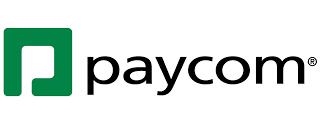
Designing better ways to work by providing cutting-edge products and exceptional experiences within HR, Talent, Time Management, Benefits and Payroll.

THANK YOU
Aimed Alliance is a non-profit organization that seeks to protect and enhance the rights of health care consumers and providers.
a
LEARN
LEARN MORE LEARN MORE PARTNER WITH US
Paychex, Inc. (Nasdaq: PAYX) is
leading provider of integrated human capital management software solutions for human resources, payroll, benefits, and insurance services.
MORE
LEARN MORE
VIRTUAL EVENTS
The State of Human Experience in the Workplace
August 16, 2023
The Future of Talent Acquisition
September 6-7, 2023
The Future of Personalized HR Services and Experiences
View our Upcoming Virtual Conference Schedule and Register Today!
WEBCASTS WEBCASTS
HR Pro to HR Pro: Preventing and Counteracting the Effects of Employee Burnout
Barbara Corcoran Talks the Total Economic Impact of Paycom
Growing needs, evolving trends: What global employees expect from fertility benefits today
How to Center Your Learning Environment Around Your People
Building a Talent Magnet Organization: Secrets to Attracting and Retaining Top Talent
September 13, 2023
August 2, 2023
August 15, 2023
PM - 4:00 PM ET
August 16, 2023
August 23, 2023
- 12:00 PM ET
September 6, 2023
-
View our Upcoming Webcasts Schedule and Register Today!
REGISTER
3:00
REGISTER
11:00 AM
1:00
2:00
REGISTER
PM -
PM ET
11:00
REGISTER
EVENTS & HR.COM WEBCASTS UPCOMING
AM
12:00 PM ET
VIRTUAL
www.hr.com/upcoming_webcasts www.hr.com/virtualconferences
1:00
2:00
ET REGISTER
PM -
PM
REGISTER
REGISTER
REGISTER




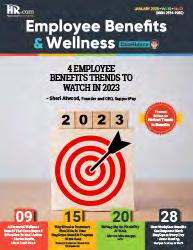
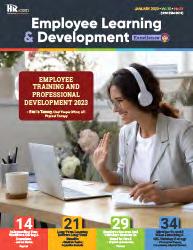



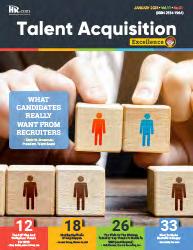



Publications 13 Targeted Publications to Reach Your Audience Informing, Educating, Enlightening and Assisting HR professionals in their personal and professional development, the Excellence series offers high-quality content through the publications! Like to submit an article? Use our online submission form or for more information go to www.hr.com/ExcellencePublications

For more information: Phone: 1.877.472.6648 | Email: ePubeditors@hr.com | www.HR.com/epubs Employee Benefits & Wellness Excellence July 2023


















 Winkle
Winkle








 Rensis Likert Professor, Ross School of Business, University of Michigan Partner, The RBL Group
Rensis Likert Professor, Ross School of Business, University of Michigan Partner, The RBL Group







































